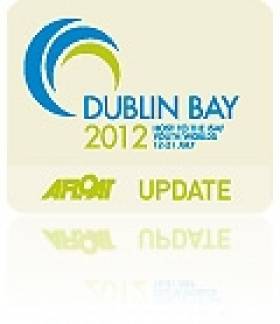Displaying items by tag: Dun Laoghaire Week
Dublin Bay World Youth Championships to Boost Irish Sailing
When the ISAF World Youth Sailing Championships are hosted on Dublin Bay in 2012 the regatta should be representative of the best of Irish sailing, organisation and hospitality and ignite an immediate but lasting legacy for youth and the future of Olympic sailing in Ireland writes Andi Roberston.
It is nearly two years since the prestigious global annual championships were awarded to Ireland and the organisation of the event has now developed substantial momentum. Already a core group of around 50 volunteer officials are working on the delivery of the regatta which, with up to 450-500 sailors and coaches from as many as 60 different nations, in terms of size, logistics and delivery stands as one of ISAF's big three major multiclass events alongside the four yearly Olympic regatta, and the ISAF Sailing World Championships.
At the helm of the organisation is Brian Craig, a former flag officer of the Royal Saint George YC on Dublin Bay, who for ten years has been instrumental in attracting, developing and running major regattas on these expansive world class racing waters, including the huge success that has been Dun Laoghaire Week. In particular a recent success has been pooling the resources of the Bay's major clubs to attract and manage big events.
"I think we are really in pretty good shape. There is a big groundswell of enthusiasm and excitement and we are drawing on that to develop a really first class, memorable event." Craig comments.
An advisory group composed of renowned experts who have many years of experience of the event in particular is at the core of organisation just now, including Bill O'Hara, International Judge and Volvo Ocean race officer, Jim Saltonstall the British coach who has attended almost all of the ISAF/IYRU Youth World Championships and helped develop a galaxy of Youth Worlds and Olympic medallists, Ken Ryan – a former ISAF Vice President who has more than 25 years of experience with ISAF and major events and Paddy Boyd, formerly Irish Sailing CEO and now Director of Canadian sailing's national governing. body.
It was a visit to the Youth World Championships in 2008 which convinced Craig that after ten years of development of the Clubs and infrastructure on Dublin Bay, the time was right for them to step up and land a major world class event.
"Now we have plenty of support for the event. We have government backing, the three major clubs, the Royal St George, the National Yacht Club and the Royal Irish are all behind us, the waterfront organisations, the tourist boards and the town itself. The support is great." Craig explains.
A delegation were in Istanbul at the last ISAF Youth World Championships in 2010 and in Croatia this coming summer, as well as a team observing and learning, several members of the race teams will be hands-on on the race courses this getting first hand experience to ensure good continuity in to next year.
"We have a fantastic site. A massive 700-800 metres of frontage with the three clubs all within five minutes of each other. We will create a central sailing village feature which will have an immediate public access so that there will be maximum interaction with the public, but where the sailors can still preserve their essential privacy in competition mode. We intend to absolutely preserve the competitive integrity of the event, but to make sure it works for public access."
To create a regatta which emphasises the cosmopolitan, international flavour of the regatta, but which also fully ensure the competitors enjoy the full experience of Irish culture, race days will themed for the public around many of the key nations – so there will be a French, Australian, Spanish, Chinese days as well as the underlying Irish hospitality and craic.
And while it is inevitable that only a few Irish sailors will compete at the ISAF World Championships on their home waters, in the interim period a ISAF Youth World Championships Road Show will visit Irish Sailing Clubs to stimulate interest and awareness of the event.
"We are determined that hosting the ISAF Youth World Championships will produce a lasting legacy for Irish sailing, perhaps seeding the future for Irish Youth Worlds or even Olympic medals. And at the same time we are determined to deliver a memorable, top class event with a distinctly Irish flavour." Concludes Craig.
The 2012 ISAF Youth World Championships are scheduled for the period 12th -21st July 2012. Around 350 sailors and 100 coaches from about 60 nations are expected to attend, composing a fleet of 250 boats. The race programme will last ten days. Classes will be the Laser Radial Boys and Laser Radial Girls, 420 Boys and 420 Girls, RS:X Boys and RS:X Girls. 29er Open Skiff, and the Open Formula 16 Catamaran. Boats or boards are supplied by Laser, Nautivela, Neil Pryde, Ovington and Serena.
In recent years Dublin Bay has hosted the Topper World Championships, the Star European Championships, the 500 boat Dun Laoghaire Regatta, the Laser 4.7 Europeans, Dragon World Championships, the Etchells World Championships (Howth), the SB3 World Championships, the 470 European Championships, the Flying 15 World Championships and the 420 Junior World Championships.






























































